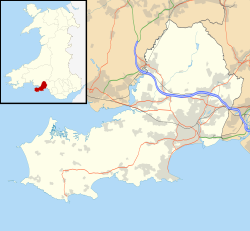RAF Fairwood Common
| RAF Fairwood Common | |||||||||||
|---|---|---|---|---|---|---|---|---|---|---|---|
| Gower Peninsula, Swansea in Wales | |||||||||||
|
Shown within Swansea
|
|||||||||||
| Coordinates | 51°36′19″N 004°04′04″W / 51.60528°N 4.06778°WCoordinates: 51°36′19″N 004°04′04″W / 51.60528°N 4.06778°W | ||||||||||
| Type | Royal Air Force station | ||||||||||
| Site information | |||||||||||
| Owner | Air Ministry | ||||||||||
| Operator | Royal Air Force | ||||||||||
| Site history | |||||||||||
| Built | 15 June 1941 | ||||||||||
| In use | 1941–1949 | ||||||||||
| Airfield information | |||||||||||
| Elevation | 83 metres (272 ft) AMSL | ||||||||||
|
|||||||||||
Royal Air Force Fairwood Common or more simply RAF Fairwood Common (IATA: EGFH, ICAO: SWS) is a former Royal Air Force station located at Fairwood Common on the Gower Peninsula to the west of Swansea. It is now the location of Swansea Airport.
RAF Fairwood Common was built on what was originally common land during the Second World War. The aerodrome was declared operational on 15 June 1941 after taking nearly a year to develop. Built as a day and night fighter station elements of the first day fighter squadron arrived on 14 June 1941 (79 Squadron equipped with Hawker Hurricane Mk.II aircraft). On 17 June 1941 the first night fighter squadron arrived (a flight of 600 Squadron equipped with Bristol Beaufighter Mk.II aircraft) and by the end of June 1941 a second Hurricane equipped day fighter squadron arrived (317 Squadron). The aerodrome became a 10 Group RAF Fighter Command Sector Station within a few months of opening, taking on the responsibility of the air defence for the whole of South and West Wales and the protection of convoys in the Bristol and St George's Channels.
On 23 January 1942, No. 615 Squadron (County of Surrey Squadron) Auxiliary Air Force, arrived from RAF Angle, equipped with Hawker Hurricane fighters, operating there until 17 March when the squadron moved by train to Liverpool Docks, boarding the Johan van Oldenbarnevelt. On 20 March the ship moved to the Firth of Clyde and then, filled with Army and RAF personnel, on 23 March it sailed in convoy to India.
...
Wikipedia

